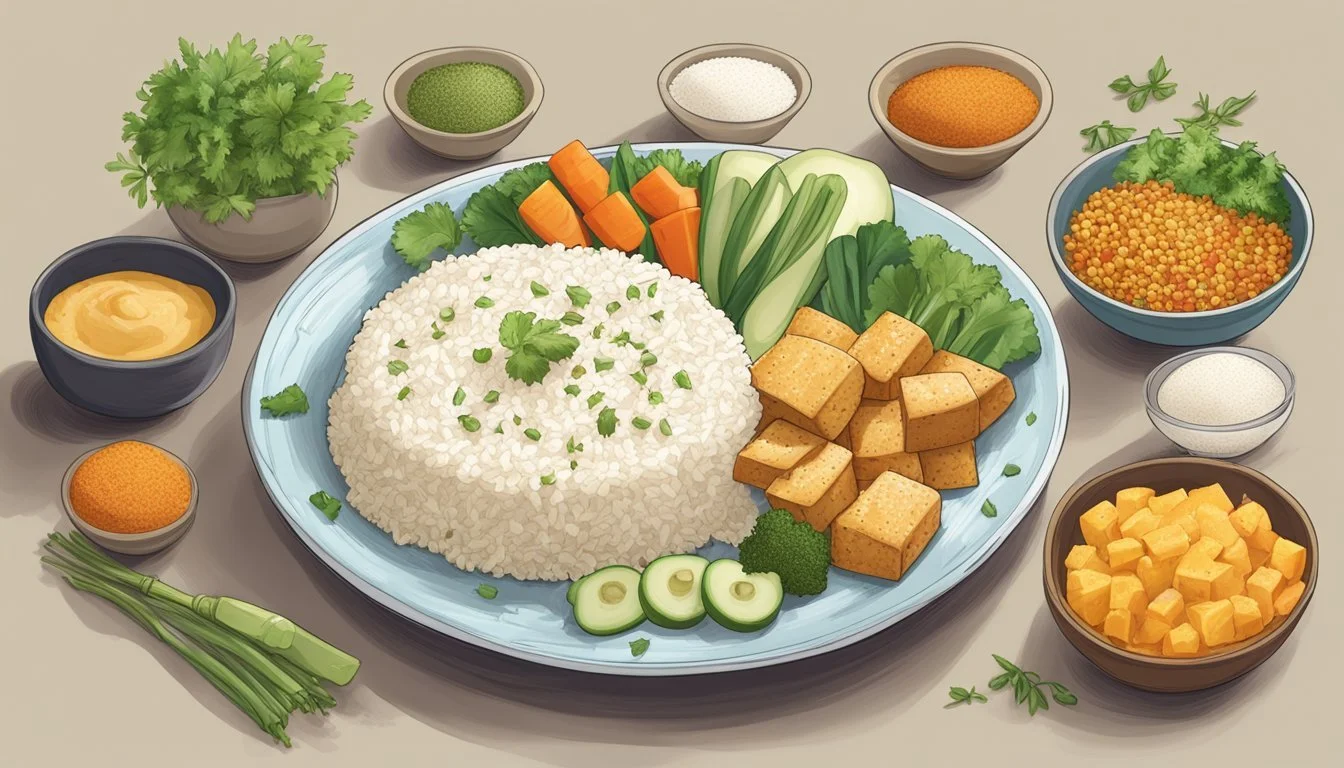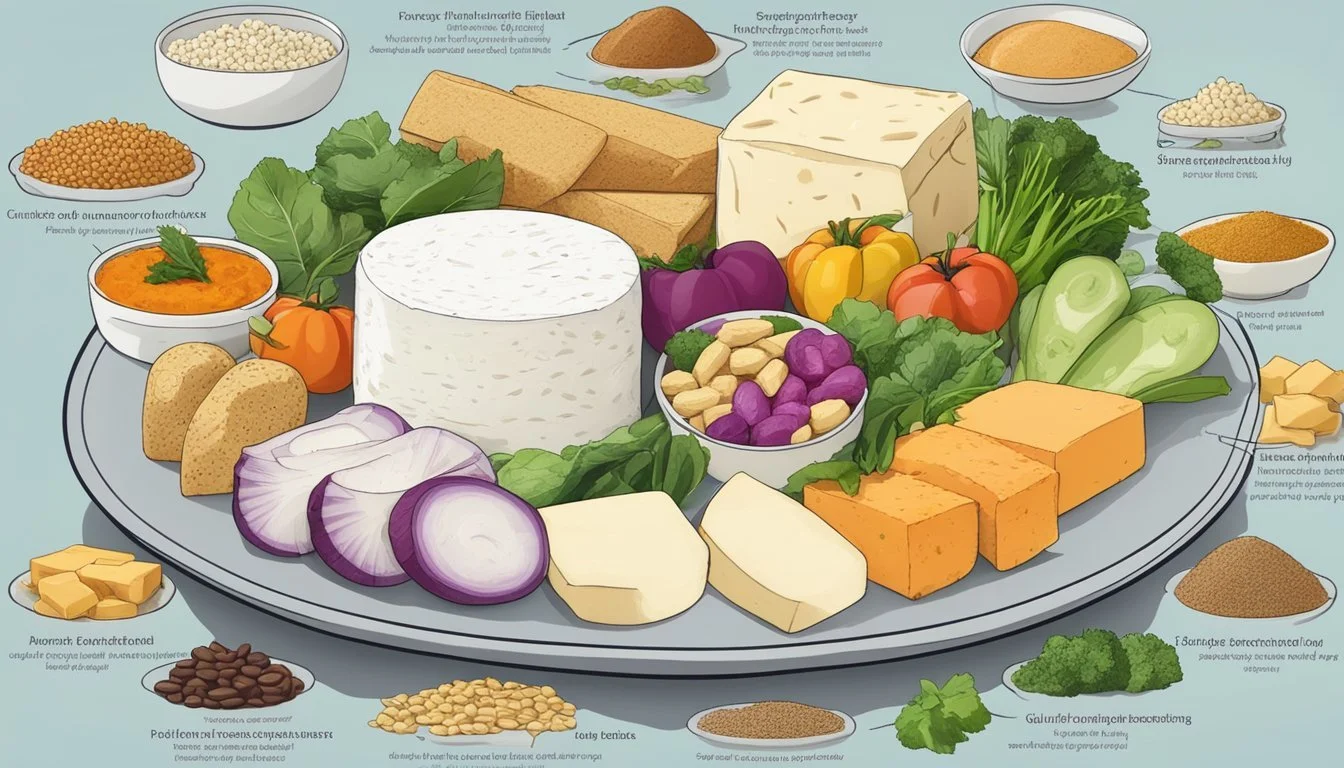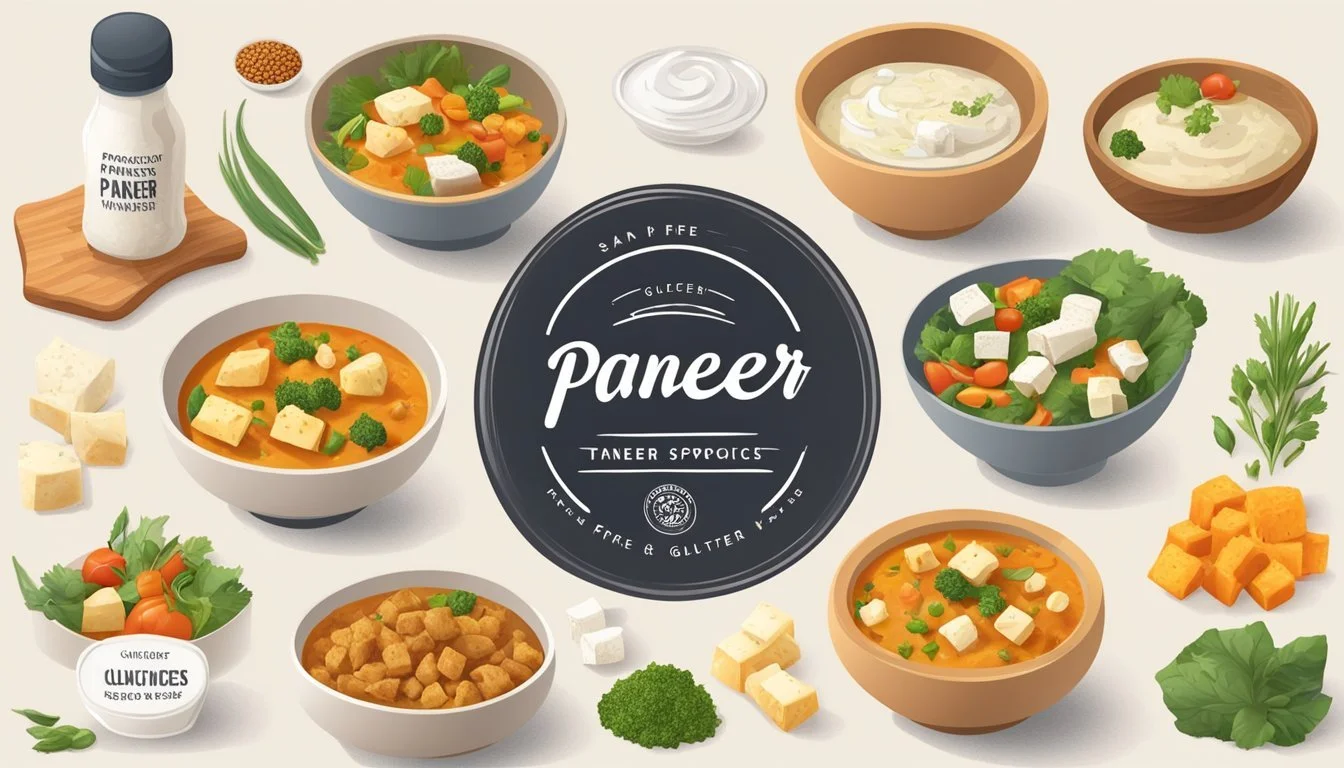Is Paneer Gluten-Free?
Unveiling the Truth for Health-Conscious Consumers
Paneer, a type of Indian cottage cheese, has gained popularity not just in Indian cuisine but also among various dietary groups worldwide. Its versatility in dishes from savory to sweet makes it a favorite choice. For individuals with celiac disease or those following a gluten-free diet, the gluten content in foods is a primary concern. Paneer is traditionally made by curdling milk with a fruit- or vegetable-derived acid, such as lemon juice or vinegar, and then separating the curds from the whey. This simple process yields a product that contains mainly milk proteins and fat, with no grains involved.
Consumers are increasingly vigilant about the foods they eat, especially when it comes to allergens and dietary restrictions. The good news for those avoiding gluten is that paneer is inherently gluten-free, given its production method. However, it is important for consumers to be aware of the potential for cross-contamination. This can occur if paneer is produced in a facility that also processes wheat or other gluten-containing grains, or if additional ingredients that contain gluten are added during the preparation of paneer dishes. Therefore, it is crucial to check labels or inquire about preparation methods when purchasing paneer or ordering paneer-based dishes, especially outside the home.
What Is Paneer?
Paneer, also known as Indian cottage cheese, is a fresh cheese common in the Indian subcontinent. It is an unaged, non-melting soft cheese made by curdling milk with a fruit- or vegetable-derived acid, such as lemon juice or vinegar.
Texture and Use: Paneer boasts a soft and crumbly texture, which makes it quite versatile in the culinary world. It can be used in an array of dishes, from savory curries to sweet desserts. Its ability to soak up flavors and maintain form when cooked makes it a favorite in Indian cuisine.
Nutritional Profile:
Protein: Paneer is rich in protein, which is essential for muscle building and repair.
Fat: It contains fats, although the content may vary based on whether whole or skimmed milk is used.
Calcium: High in calcium, paneer helps in building strong bones and teeth.
Calories: The caloric content of paneer can be considerable, due to its combined protein and fat content.
Here is a brief outline of paneer's nutritional value per 100g serving:
Nutrient Quantity Protein ~18-20g Fat ~20-25g Calcium ~208mg Calories ~265-296
Benefits: Paneer is not only favored for its taste and versatility but also for its nutritional benefits. Being rich in calcium and protein, it supports skeletal health and can contribute to a balanced diet. As part of a varied culinary tradition, paneer transcends simple nutrition to become a staple protein source for vegetarians in India.
Exploring Paneer's Gluten Content
Traditionally, paneer is a type of cheese that originates from the Indian subcontinent. It's made by curdling milk with a food acid, such as lemon juice or vinegar. This process separates the curds from the whey and results in a soft, crumbly cheese. Paneer's basic ingredients do not include wheat, barley, rye, or any other grains that contain gluten, which makes it naturally gluten-free.
When it comes to a gluten-free diet, paneer can be a suitable addition as it should inherently lack gluten. However, the integrity of paneer's gluten-free status can be compromised by cross-contamination. This risk is particularly prevalent in factories or kitchens where gluten-containing products are processed or prepared.
Consumers following a strict gluten-free diet are advised to look for certified gluten-free labels on packaged paneer. These labels indicate that the product has been tested and meets the required standards to avoid cross-contamination. It's critical for individuals with celiac disease or gluten intolerance to examine the label thoroughly, as some manufacturers may include gluten-containing additives or fillers.
Here's a quick checklist for ensuring the paneer you purchase is gluten-free:
Look for "certified gluten-free" labeling: This ensures the product has undergone testing.
Check the ingredient list: Ensure no gluten-containing additives are present.
Be aware of manufacturing statements: These can indicate if the product was made in a facility that also processes gluten-containing items.
When dining out, inquire about preparation practices to avoid cross-contamination.
In summary, while pure paneer is gluten-free, vigilance is required to maintain a gluten-free status when purchasing packaged products or consuming dishes prepared outside the home.
Paneer Preparation and Ingredients
The preparation of paneer primarily involves the curdling of milk using an acidic agent, resulting in cheese that is versatile in various recipes. This section explores the specific process and ingredients integral to paneer production.
Curdling Process
The curdling process is the first and most crucial step in making paneer. Milk is heated and then an acidic agent, commonly lemon juice or vinegar, is added. This addition causes the milk to curdle, separating the curds from the whey. After curdling, the mixture is left to rest for a short period to ensure complete separation. The curds are then collected using a muslin cloth to strain out the whey, creating the base for paneer.
Common Ingredients in Paneer Recipes
In its simplest form, paneer is made with only two ingredients: milk and an acidic agent. Here is a brief overview of commonly used ingredients in paneer recipes:
Milk: Typically, cow's milk is used for its high fat content, yielding a soft paneer.
Acidic Agent: Options include lemon juice or vinegar; their purpose is to facilitate the curdling of milk.
After curdling, the curds may sometimes be pressed to varying degrees of firmness. Salt and other spices can be added to the curds before pressing to enhance flavor, although traditional paneer is kept plain. During preparation, utensils and surfaces must be kept free from gluten contaminants to ensure the paneer remains gluten-free.
Potential for Gluten Cross-Contamination
When considering if paneer is gluten-free, one must be aware of cross-contamination risks. These can occur during both the manufacturing process and home cooking.
Manufacturing and Packaging
In the manufacturing of paneer, facilities might also process wheat and other gluten-containing products. This proximity raises the risk of gluten particles inadvertently getting mixed with the paneer. When buying paneer, consumers should look for a gluten-free label on pre-packaged items. This label indicates that products have been tested for gluten and meet the legal standards for a gluten-free claim.
Facility risk factors: shared equipment, airborne gluten, employee practices.
Precautions: dedicated gluten-free production lines, regular equipment cleaning, staff training.
Home Cooking Risks
At home, the potential for gluten exposure increases if the kitchen is used to prepare both gluten-containing and gluten-free foods.
Utensils and Appliances: Porous materials and appliances with crevices, like blenders or bread makers, can harbor gluten particles despite thorough cleaning.
Surface contamination: Gluten particles can remain on countertops, cutting boards, and cloth towels, finding their way into gluten-free paneer dishes.
Best practices at home:
Use separate, clearly marked utensils and cutting boards for gluten-free cooking.
Regularly clean kitchen surfaces before preparing gluten-free meals.
Store gluten-free items separately to avoid cross-contamination from crumbs or flour dust.
Paneer in Indian Cuisine
Paneer, the versatile cheese hailing from Indian cuisine, graces numerous traditional dishes with its soft, crumbly texture. It is the protagonist in an array of vegetarian recipes, admired for its ability to absorb flavors while providing a hearty protein component.
Traditional Paneer Dishes
Paneer serves as a staple ingredient in a myriad of classic Indian recipes. Paneer tikka features cubes of paneer marinated in spices and then grilled, delivering a smoky richness. Palak paneer combines this cheese with a creamy spinach sauce, where the mildness of paneer perfectly balances the robust greens. Paneer butter masala offers a richer experience, with the cheese simmering in a velvety tomato-based sauce infused with butter and cream. Paneer bhurji, a scramble of crumbled paneer with tomatoes, onions, and spices, showcases its more casual side. Lastly, paneer pakoras are a beloved snack where paneer is coated in chickpea flour batter and deep-fried to golden perfection.
Pairing with Gluten-Free Accompaniments
Numerous paneer dishes can be adapted for a gluten-free diet by pairing them with suitable accompaniments. Instead of the traditional roti (wheat-based flatbread), one might opt for a variety of rice options. Basmati rice is a fragrant and long-grain variety that often acts as a fluffy bed for saucy paneer curries like paneer butter masala. Those avoiding gluten can also consider dishes that inherently do not contain grains, like paneer tikka, served typically on its own or with a side of vegetables. When it comes to navigating Indian cuisine for gluten-free options, the key is to ensure that sides and seasonings used with paneer are also devoid of gluten.
Nutritional Profile of Paneer
Paneer, a type of Indian cottage cheese, is notable for its high protein content and its potential place in a nutritious diet. Typically, 100 grams of paneer provides about 18.3 grams of protein, which is substantial for muscle maintenance and growth. This same serving size also contains approximately 265 kcal and 20 grams of fat, making it energy-dense and high in fat. Despite the higher fat content, it's a source of healthy fats that are essential for the body's functions.
Paneer offers a moderate amount of carbohydrates, with negligible fiber, given that it is a dairy product. For individuals monitoring their carb intake, paneer can be a suitable option. In terms of vitamins and minerals, paneer is rich in calcium and phosphorus, essential nutrients for bone health. It also provides a source of other essential nutrients necessary for various body processes.
Below is a tabular overview of the nutritional content found in paneer:
Nutrient Amount per 100g Calories 265 kcal Protein 18.3 g Fat 20 g Carbohydrates < 3 g Fiber 0 g Calcium Varies Phosphorus Varies Sodium Varies Cholesterol Varies
It's important to note that the exact amounts of sodium and cholesterol in paneer can vary depending on the manufacturing process. However, they may contribute to the daily intake limits for these nutrients.
Though paneer is high in certain fats and calories, it can be included as part of a balanced diet, especially when considering its contribution to protein and essential nutrient intake. Individuals should moderate their intake based on their specific dietary needs and preferences.
Dietary Considerations for Gluten Sensitivity
When managing gluten sensitivity, one must distinguish between celiac disease and non-celiac gluten sensitivity to cater to their dietary needs effectively. The inclusion or avoidance of certain cheeses, such as paneer, becomes a pivotal point in this consideration.
Celiac Disease and Non-Celiac Gluten Sensitivity
Individuals with celiac disease (CeD) must adhere to a strict gluten-free diet as their immune system reacts negatively to gluten—a protein commonly found in wheat, barley, and rye—leading to intestinal damage. Non-celiac gluten sensitivity (NCGS), while less understood, also necessitates the avoidance of gluten, despite the absence of the same immune response. People with NCGS report similar symptoms that improve with a gluten-free diet, even without the intestinal damage seen in celiac disease.
Gluten-Free Diet and Cheese Alternatives
A gluten-free diet involves eliminating all sources of gluten. While many cheese products are inherently gluten-free, cross-contamination can be an issue, especially for those with celiac disease. Paneer, a type of cheese made from milk and an acidic agent, is generally safe for a gluten-free diet, provided it is prepared in a gluten-free environment. Individuals with dairy restrictions, in addition to gluten sensitivity, might opt for dairy-free alternatives like tofu, which can also be incorporated into vegan diets due to its plant-based origin. It is crucial to check labels for both hidden gluten and dairy ingredients when purchasing processed cheese alternatives, as they may vary in their composition and processing environments.
Paneer Recipes and Gluten-Free Alternatives
Paneer, a type of cottage cheese popular in Indian cuisine, can be safely included in a gluten-free diet. Home cooks can prepare a variety of paneer dishes that align with gluten-free cooking practices, ensuring that those with gluten sensitivities can enjoy its rich, versatile flavor.
Gluten-Free Paneer Recipes
Paneer is inherently gluten-free, making it a suitable choice for those avoiding gluten. When preparing paneer recipes at home, it's crucial to use gluten-free ingredients, especially in marinades, sauces, and batters, which can be sources of hidden gluten.
Paneer Tikka: Grill chunks of paneer with oil and a gluten-free marinade made from yogurt, lemon juice, and gluten-free spices.
Batter: Combine chickpea flour with spices and water to create a gluten-free batter for paneer pakora.
Paneer Butter Masala: Simmer paneer in a rich sauce using gluten-free tomato paste, cream, and a blend of gluten-free spices like garam masala and cumin.
In baking and grilling recipes, it is important to ensure that all spice blends used are labeled as gluten-free to avoid cross-contamination. Cooks should diligently check the labels of all purchased ingredients to verify their gluten-free status.
Substitutions in Cooking
When adapting traditional paneer recipes to be gluten-free, certain substitutions may be necessary:
Flour Substitutes: Use gluten-free flour blends, almond flour, or chickpea flour in place of wheat flour for coating or thickening sauces.
Soy Sauce Alternative: Opt for tamari or a certified gluten-free soy sauce to prevent any unwanted gluten from being introduced.
Home cooks should also be cautious of cross-contamination during the preparation of gluten-free dishes. Using separate utensils and cookware dedicated to gluten-free cooking can mitigate this risk. When dining out, individuals must communicate dietary restrictions to ensure that their paneer dishes are prepared in a gluten-free-friendly manner.
Cooking Techniques and Tips
In preparing paneer dishes, achieving a desirable texture and flavor is crucial, especially when maintaining a gluten-free diet. This section provides techniques to perfect the texture and enhance the flavor of paneer without introducing gluten.
Achieving the Perfect Texture
To attain that sought-after firmness and a golden-brown exterior when cooking paneer, it's vital that one first presses the paneer to remove excess moisture. For a crispy exterior, one should heat oil or butter in a pan and cook the paneer on medium heat until each side is golden brown. This not only improves texture but also adds a rich flavor.
Press paneer for 20 minutes to dry.
Cook in oil/butter for 3-5 minutes each side until golden brown.
Enhancing Flavor Without Gluten
The taste of paneer can be significantly heightened with the right selection of spices and marinating techniques. Marinades can infuse paneer with flavor and moisture. To remain gluten-free, use a mix of spices such as coriander powder, cumin seeds, fennel seeds, turmeric powder, and red chili powder. Sauteing onions, ginger, and garlic until aromatic before adding the paneer to the pan brings another dimension of flavor. Additionally, incorporating a variety of vegetables like bell peppers adds freshness and a flavorful crunch.
Marinade: Combine spices like coriander, cumin, and turmeric in oil.
Saute aromatics: Begin with onions, ginger, garlic; then add paneer and vegetables.
Differences Between Paneer and Other Cheeses
Paneer stands out among cheeses for its unique preparation method and its suitability for certain dietary restrictions.
Paneer vs. Cottage Cheese
Paneer is often confused with cottage cheese due to their similar appearance and fresh cheese category, but they differ in consistency and production process. Paneer is a type of cheese that originated in India, and it is known for its firm texture that makes it ideal for cooking because it does not melt. To make paneer, milk is curdled with a fruit- or vegetable-derived acid, such as lemon juice or vinegar. The curds are then pressed to expel the whey, resulting in a dense block of cheese.
In contrast, cottage cheese is a western dairy product with a more crumbly and soft texture. Unlike paneer, cottage cheese may have a creamy component, as it is not pressed into a firm block, allowing for some whey to remain in the final product. The curds in cottage cheese are also smaller and it has a slightly tangy flavor.
Comparison with Dairy and Non-Dairy Cheese
Dairy cheeses like paneer are made from cow's milk, whereas non-dairy cheeses are typically made from plant-based sources and designed for those following a vegan or dairy-free diet. The most common base for vegan cheese is tofu, an alternative derived from soy milk.
Dairy cheese: Most cheeses fit into this category and share common attributes such as the presence of milk proteins and potential for a variety of textures from soft to hard. All dairy-based cheeses typically contain lactose to some extent, which some individuals may be sensitive to.
Non-Dairy cheese: Designed to be dairy-free, these cheeses are suitable for vegans and those with lactose intolerance. They lack milk proteins and are often made from nuts, vegetable oils, soy, and other plant sources. Though similar in appearance, they noticeably differ from dairy cheeses in taste and texture due to the absence of milk fats and proteins.
Health Benefits and Risks
Paneer, an Indian cottage cheese, is heralded for its high nutritional value, especially when it comes to protein and calcium content. One of the key benefits highlighted by nutritionists is its role in supporting bone health, which makes it a favorable dietary inclusion for the prevention of osteoporosis. Paneer provides a considerable amount of protein, essential for muscle maintenance and repair. Additionally, its calcium content contributes to the strengthening of bones and teeth.
The cheese also supplies a moderate amount of fat, which can be beneficial when consumed in moderation as part of a balanced diet. However, for individuals monitoring their fat intake, particularly saturated fat, it is important to consume paneer in controlled portions since it can contribute to cholesterol levels.
Here's a quick overview of the nutritional components related to the health benefits and risks of paneer:
Protein: Essential for muscle repair and growth.
Calcium: Crucial for bone health and may help in preventing osteoporosis.
Fat: Provides energy but should be eaten in moderation due to its saturated fat content.
On the flip side, individuals with existing heart conditions should be cautious about their paneer consumption due to its cholesterol content. Excessive intake may have adverse effects on heart health. It's recommended to opt for low-fat versions if cholesterol levels are a concern.
It must be noted, for those adhering to a gluten-free diet, that paneer itself is gluten-free. Nevertheless, in practice, its preparation or the context in which it is used could introduce a risk of gluten contamination. One must ensure that the paneer they consume has not been cross-contaminated with gluten-containing ingredients, especially if they have celiac disease or gluten intolerance.
Conclusion
Paneer is a type of cheese commonly consumed in South Asian cuisine, particularly in Indian dishes. It is inherently gluten-free, given that it is made from milk and an acid coagulant such as lemon juice or vinegar, without any grains or grain-derived ingredients involved in its production.
Consumers with gluten sensitivities or celiac disease can generally incorporate paneer into their diets. However, vigilance is paramount when paneer is part of a dish outside the home, as cross-contamination with gluten-containing ingredients can occur during preparation.
When purchasing paneer, individuals should:
Read labels carefully to ensure no gluten-containing additives are present.
Opt for pure paneer that lists only milk and an acidic agent in its ingredients.
In restaurants, it's essential for consumers to:
Inquire whether any flour or flour-based sauces are used in the preparation of the paneer dish.
Make staff aware of their gluten intolerance or celiac condition to avoid cross-contamination.
In summary, paneer itself is gluten-free and safe for those avoiding gluten. Care should always be taken to ensure that it has not been contaminated with gluten during its preparation or in the creation of paneer-based dishes.












